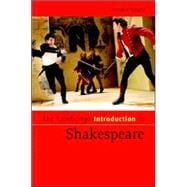
Note: Supplemental materials are not guaranteed with Rental or Used book purchases.
Purchase Benefits
What is included with this book?
| List of figures and tables | p. viii |
| Preface | p. ix |
| Character | p. 1 |
| Juliet's balcony, Verona | p. 1 |
| Shakespeare's realism? | p. 3 |
| Shakespeare's 'unreal' characters | p. 4 |
| Reading Shakespeare's characters on the page | p. 6 |
| Embodying Shakespeare's characters on stage | p. 7 |
| Doubling on the early modern stage | p. 8 |
| Writing for particular actors | p. 11 |
| Falstaff: character as individual or type? | p. 12 |
| Naming and individuality | p. 12 |
| Characters as individuals or as inter-relationships | p. 14 |
| Character: interior or exterior? | p. 17 |
| Character: where next? | p. 19 |
| Performance | p. 23 |
| Measure for Measure: staging silence | p. 23 |
| 'Going back to the text': the challenge of performance | p. 26 |
| Performance interpretations: The Taming of the Shrew | p. 27 |
| Topical performance: the plays in different theatrical contexts | p. 30 |
| Citing performances | p. 32 |
| Using film | p. 33 |
| Using film comparatively: Macbeth | p. 35 |
| Hamlet: 'To be or not to be' | p. 39 |
| Adaptations: Shakespearean enough? | p. 41 |
| Performance: where next? | p. 42 |
| Texts | p. 46 |
| Shakespeare's hand | p. 46 |
| So what did Shakespeare write? | p. 47 |
| Stage to page | p. 48 |
| Quartos and Folio | p. 49 |
| Editing as interpretation | p. 50 |
| The job of the editor: the example of Richard II | p. 53 |
| Stage directions | p. 57 |
| Speech prefixes | p. 60 |
| The job of the editor: the example of King Lear | p. 61 |
| Texts: where next? | p. 65 |
| Language | p. 71 |
| 'In a double sense'(Macbeth 5.7.50) | p. 71 |
| Did anyone really talk like that? | p. 72 |
| Playing with language | p. 77 |
| Language of the play / language of the person | p. 79 |
| Prose and verse | p. 81 |
| Linguistic shifts: 1 Henry IV | p. 82 |
| Shakespeare's verse | p. 84 |
| Linguistic variation: A Midsummer Night's Dream | p. 85 |
| Language: where next? | p. 87 |
| Structure | p. 90 |
| Finding the heart of the play | p. 90 |
| Shakespeare's genres: dynamic, not static | p. 93 |
| Tragedy and comedy | p. 94 |
| Tragedy - expanding the genre | p. 95 |
| Comedy - expanding the genre | p. 98 |
| History: is this a fixed genre? | p. 101 |
| Structuring scenes: Much Ado About Nothing | p. 103 |
| Juxtaposing scenes, activating ironies: Henry V | p. 104 |
| Showing v. telling | p. 106 |
| Structure: where next? | p. 107 |
| Sources | p. 113 |
| Antony and Cleopatra and Plutarch | p. 113 |
| Originality: was Shakespeare a plagiarist? | p. 116 |
| Shakespeare at work: the intentional fallacy? | p. 118 |
| The source bites back: Romeo and Juliet and The Winter's Tale | p. 120 |
| The strong poet? King Lear | p. 127 |
| Sources: where next? | p. 131 |
| History | p. 134 |
| Politic picklocks: interpreting topically | p. 134 |
| History plays: political Shakespeare? | p. 136 |
| History plays: Shakespeare as propagandist? | p. 138 |
| Hamlet as history play? | p. 140 |
| Jacobean patronage: King Lear and Macbeth | p. 142 |
| Historical specificity: gender roles | p. 144 |
| Race and Othello | p. 148 |
| History: where next? | p. 153 |
| Bibliography | p. 157 |
| Index | p. 162 |
| Table of Contents provided by Ingram. All Rights Reserved. |
The New copy of this book will include any supplemental materials advertised. Please check the title of the book to determine if it should include any access cards, study guides, lab manuals, CDs, etc.
The Used, Rental and eBook copies of this book are not guaranteed to include any supplemental materials. Typically, only the book itself is included. This is true even if the title states it includes any access cards, study guides, lab manuals, CDs, etc.